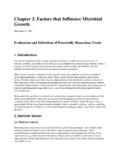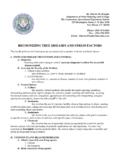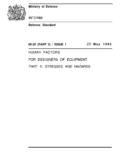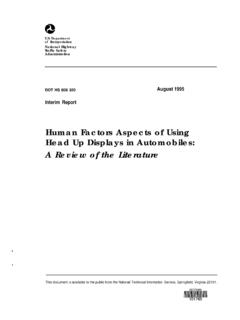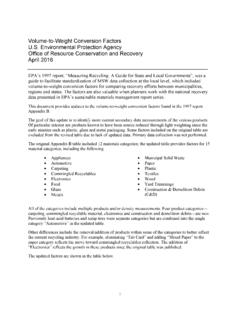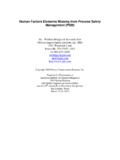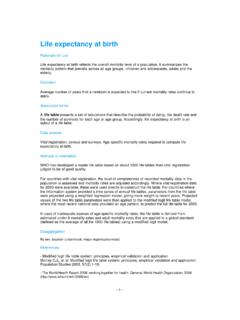Transcription of Toxicity equivalence factors for marine biotoxins ...
1 JOINT FAO/WHO. T E C H N I C A L PA P E R. Toxicity Equivalency factors for marine biotoxins associated with Bivalve Molluscs Cover photograph: FAOemergencies JOINT FAO/WHO. T E C H N I C A L PA P E R. Toxicity equivalence factors for marine biotoxins associated with bivalve molluscs FOOD AND AGRICULTURE ORGANIZATION OF THE UNITED NATIONS. WORLD HEALTH ORGANIZATION. ROME, 2016. Recommended citation: FAO/WHO. 2016. Technical paper on Toxicity Equivalency factors for marine biotoxins associated with Bivalve Molluscs. Rome. 108 pp. The designations employed and the presentation of material in this publication do not imply the expression of any opinion whatsoever on the part of the Food and Agriculture Organization of the United Nations (FAO) or of the World Health Organization (WHO) concerning the legal status of any country, territory, city or area or of its authorities, or concerning the delimitation of its frontiers or boundaries.
2 Dotted lines on maps represent approximate border lines for which there may not yet be full agreement. The mention of specific companies or products of manufacturers, whether or not these have been patented, does not imply that these are or have been endorsed or recommended by FAO or WHO in preference to others of a similar nature that are not mentioned. Errors and omissions excepted, the names of proprietary products are distinguished by initial capital letters. All reasonable precautions have been taken by FAO and WHO to verify the information contained in this publication. However, the published material is being distributed without warranty of any kind, either expressed or implied. The responsibility for the interpretation and use of the material lies with the reader. In no event shall FAO and WHO be liable for damages arising from its use. The views expressed herein are those of the authors and do not necessarily represent those of FAO or WHO.
3 ISBN 978-92-5-109345-0 (FAO). ISBN 978-92-4-151148-3 (WHO). FAO and WHO, 2016. FAO and WHO encourage the use, reproduction and dissemination of material in this information product. Except where otherwise indicated, material may be copied, downloaded and printed for private study, research and teaching purposes, provided that appropriate acknowledgement of FAO. and WHO as the source and copyright holder is given and that FAO and WHO's endorsement of users'. views, products or services is not implied in any way. All requests for translation and adaptation rights, and for resale and other commercial use rights should be made via or addressed to FAO information products are available on the FAO website ( ) and can be purchased through Contents ACKNOWLEDGEMENTS v ABBREVIATIONS AND ACRONYMS vi PREPARATION AND PURPOSE OF THIS DOCUMENT ix DEFINITIONS OF TERMS USED xi EXECUTIVE SUMMARY xv Criteria used for determining TEFs xvi Bivalve- associated toxins xvi Methods for detection of bivalve associated biotoxins xvii Toxicity Equivalency factors (TEFs) for specific biotoxins xix Data gaps and further considerations for research xxi Recommendations for risk managers xxi 1 THE NEED FOR AND CONCEPT OF Toxicity EQUIVALENCY.
4 factors 1. The need for Toxicity Equivalency factors 1. TEF: use of the concept 2. Deriving TEFs 4. Criteria for assigning TEFs 7. 2 CHEMISTRY AND DETECTION METHODS FOR biotoxins 9. Chemical nature and molecular structure of analogues 9. Saxitoxin and analogues 10. Okadaic acid and analogues 13. Domoic acid and analogues 16. Azaspiracids and analogues 18. Tetrodotoxin and analogues 22. Brevetoxin and analogues 24. Detection methods 25. Saxitoxins 27. Okadaic acid and Azaspiracid and their analogues 27. Domoic acid and analogues 28. Brevetoxin and analogues 29. 3 Toxicity EQUIVALENCY factors (TEFS) FOR SPECIFIC. BIOTOXIN GROUPS 30. Considerations for the establishment of TEFs 30. Saxitoxin and analogues 30. Toxicity of epimers and influence of hydrolysis 35. Conclusion 35. Okadaic acid and analogues 38. Acute Toxicity 39. Toxicity of OA and analogues to cells in vitro 41. Diarrhetic effect 42. Intestinal mucosa effect 44.
5 Conclusion 45. Domoic acid and analogues 48. Toxicity 48. Conclusion 50. Azaspiracid and analogues 50. Toxicity 50. In vitro relative potency 53. Conclusion 54. Brevetoxins 55. Conclusions 55. 4 DATA GAPS AND RECOMMENDATIONS FOR RESEARCH 57. Data Gaps for each group for which TEFs were considered 57. STX 57. OA 57. Domoic Acid 58. AZA 58. Considerations for other biotoxins 58. The special case of tetrodotoxin (TTX) 58. Yessotoxin and analogues 60. Pectenotoxin 63. Palytoxin and analogues 64. Cyclic imines 65. 5 RECOMMENDATIONS FOR RISK MANAGERS 66. TEFs recommended for each biotoxin group by the Expert Group 68. Saxitoxins 68. OA 69. Domoic Acid 69. AZAs 70. 6 REFERENCES 71. Annex 1 Oshima relative Toxicity 108. iv FAO/WHO TECHNICAL PAPER ON Toxicity EQUIVALENCY factors FOR marine biotoxins . associated WITH BIVALVE MOLLUSCS. Acknowledgements The Food and Agriculture Organization of the United Nations (FAO) and the World Health Organization (WHO) would like to express their appreciation to all those who contributed to the preparation of this document through the provision of their time, expertise and other relevant information before, during and after the Joint FAO/WHO Expert Meeting on Toxicity Equivalency factors for marine biotoxins , in particular Professor Luis Botana (University of Compostela, Spain), Dr Philipp Hess (IFREMER, France), Dr Rex Munday (AgResearch Ltd, New Zealand), Dr Nathalie Arnich (ANSES, France), Dr Stacey Degrasse (US FDA), Dr Mark Feeley (Health Canada), Dr Toshiyuki Suzuki (National Research Institute of Fisheries Science, Japan) and Professor Martin Van den Berg (Utrecht University, Netherlands).
6 Appreciation is also extended to Gloria Loriente (FAO. Fisheries and Aquaculture Department) for her professional work in the layout design and publishing of this report. This work was coordinated by the FAO and WHO Secretariat: Iddya Karunasagar and Esther Garrido Gamarro (Products, Trade and Marketing Branch, Fisheries and Aquaculture Department, FAO); Vittorio Fattori (Food Safety and Quality Unit, Agriculture and Consumer Protection Department, FAO); and Angelika Tritscher and Rei Nakagawa (Department of Food Safety and Zoonoses, WHO). DECLARATIONS OF INTEREST. All participants in the Joint FAO/WHO Expert Meeting on Toxicity Equivalency factors for marine biotoxins completed a Declaration of Interest form in advance of the meeting. None were considered to present any potential conflict of interest. ACKNOWLEDGEMENTS v Abbreviations and acronyms AhR aryl hydrocarbon receptor AMPA alphaamino-5-methyl-3-hydroxyisoxazolone -4-propionate AOAC Association of Official Analytical Chemists APHA American Public Health Association ARfD acute reference dose ASP amnesic shellfish poisoning AZA azaspiracid AZP azaspiracid poisoning BTX brevetoxin body weight CAC Codex Alimentarius Commission CCFFP Codex Committee on Fish and Fishery Products CCMAS Codex Committee for Methods of Analysis and Sampling CEN Comit Europ en de Normalisation (European Committee for Standardization).
7 CID Collusion induced dissociation CONTAM Panel Panel on Contaminants in the Food chain (EFSA). DA domoic acid dcGTX1 4 Decarbamoyl gonyautoxin 1 4. dc-NeoSTX Decarbamoyl neosaxitoxin dcSTX Decarbamoyl saxitoxin vi FAO/WHO TECHNICAL PAPER ON Toxicity EQUIVALENCY factors FOR marine biotoxins . associated WITH BIVALVE MOLLUSCS. DSP diarrhetic shellfish poisoning DTX dinophysistoxin EFSA European Food Safety Authority ELISA Enzyme-linked immunosorbent assay EU European Union FAO Food and Agriculture Organization of the United Nations FL fluorescence method GTX gonyautoxin HCl hydrochloric acid HPLC high-performance liquid chromatography HPLC-FLD High-performance liquid chromatography-fluorescence detection IC50 Inhibitory concentration - the concentration of a substance that reduces the effect by 50%. IOC Intergovernmental Oceanographic Commission of UNESCO. ISO International Organization for Standardization IUPAC International Union of Pure and Applied Chemistry intraperitoneal intravenous LC liquid chromatography LC-MS liquid chromatography with mass spectrometry detection LC-MS/MS liquid chromatography-tandem mass spectrometry LC-UV liquid chromatography with ultraviolet detection LD50 median lethal dose LOAEL lowest observable adverse effect level MBA mouse bioassay MLD minimum lethal dose MS mass spectrometry MU Mouse Unit NeoSTX neosaxitoxin NMDA N-methyl-D-aspartate NMR nuclear magnetic resonance NOAEL no observable adverse effect level NSP neurotoxic shellfish poisoning ABBREVIATIONS AND ACRONYMS vii NSSP National Shellfish Sanitation Program OA okadaic acid PBDD polybrominated dibenzo-p-dioxin PBDF polybrominated dibenzofuran PCB polychlorinated biphenyle PCDF polychlorinated dibenzofuran PSP paralytic shellfish poisoning RBA
8 Receptor-binding assay RfD reference dose REP relative effect potency STX saxitoxin TDI tolerable daily intake TEF Toxicity equivalence factor TFA Trifuoroacetic acid US-EPA United States Environmental Protection Agency UV ultraviolet WHO World Health Organization viii FAO/WHO TECHNICAL PAPER ON Toxicity EQUIVALENCY factors FOR marine biotoxins . associated WITH BIVALVE MOLLUSCS. Preparation and purpose of this document BACKGROUND. On the basis of the Joint FAO/IOC/WHO ad hoc Expert Consultation on biotoxins in Bivalve Molluscs (FAO/IOC/WHO, 2004), the Codex Committee on Fish and Fishery Products (CCFFP) has developed the Standard for Live and Raw Bivalve Molluscs (CODEXSTAN 292 2008, ). The Standard includes the following provisions for biotoxins : Name of biotoxin group Maximum level per kg of mollusc flesh Saxitoxin (STX) group mg (2 HCL) of saxitoxin equivalent Okadaic acid (OA) group < mg of okadaic acid equivalent Domoic acid (DA) group < 20 mg domoic acid Brevetoxin (BTX) group < 200 mouse units or equivalent Azaspiracid (AZA) group < mg Each of these biotoxin groups includes several analogues and the limit in the Codex standard is expressed as the level of a reference toxin.
9 The 34th Session of Codex Committee on Methods of Analysis and Sampling (CCMAS) encouraged CCFFP to elaborate Toxicity Equivalency factors (TEFs). for all biotoxins listed in the standard and to establish appropriate sampling plans. The 33rd Session of CCFFP developed performance criteria for reference and confirmatory methods for marine biotoxins included in the standard. However, the CCFFP agreed that it was premature to include TEFs as part of the standard and requested FAO/WHO to provide scientific advice in this area. PREPARATION AND PURPOSE OF THIS DOCUMENT ix FAO/WHO EXPERT MEETING ON TEFS FOR marine . biotoxins . Following the request from CCFFP, FAO/WHO agreed to develop a technical document presenting the status of science of marine biotoxins associated with bivalve molluscs, toxin analogues and their biological activity. Professor Luis Botana (University of Compostela, Spain) and Dr Philipp Hess (IFREMER, France).
10 Prepared the first draft consisting of two major sections (a) chemistry of biotoxins and methods of analysis, and (b) TEFs for biotoxins . The draft was circulated and reviewed by a group of experts including Dr Rex Munday (AgResearch Ltd, New Zealand), Dr Nathalie Arnich (ANSES, France), Dr Stacey Degrasse (United States Food and Drug Administration), Dr Mark Feeley (Health Canada), Dr Toshiyuki Suzuki (National Research Institute of Fisheries Science, Japan) and Professor Martin Van den Berg (Utrecht University, Netherlands). The technical paper was discussed and finalized by th above Expert Group during the Joint FAO/WHO. Expert Meeting on Toxicity Equivalency factors for marine biotoxins held in Rome on 22 24 February 2016. The meeting was chaired by Professor Martin Van den Berg and Luis Botana was the rapporteur. x FAO/WHO TECHNICAL PAPER ON Toxicity EQUIVALENCY factors FOR marine biotoxins . associated WITH BIVALVE MOLLUSCS.










